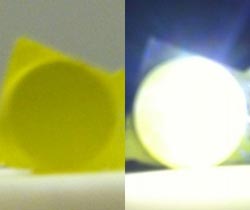Bright, Laser-Based Lighting Devices

K.Denault/UCSB<br><br>Photograph of bright white light (right) achieved using lasers in combination with phosphors next to an image of the phosphor with no illumination.<br>
As a modern culture, we crave artificial white lights — the brighter the better, and ideally using less energy than ever before. To meet the ever-escalating demand for more lighting in more places and to improve the bulbs used in sports stadiums, car headlights and street lamps, scientists are scrambling to create better light-emitting diodes (LEDs) — solid state lighting devices that are more energy efficient than conventional incandescent or fluorescent light sources.
Just one thing stands in the way: “droop,” the term for a scientific problem related to LEDs currently in use. Droop refers to the fact that LED efficiency falls as operating currents rise, making the lights too hot to power in large-scale applications. Many scientists are working on new methods for modifying LEDs and making progress toward cooler, bigger and brighter bulbs.
Now investigators at University of California, Santa Barbara, led by material scientists Kristin A. Denault and Michael Cantore, have devised an alternative means of creating high-power white light by using a different excitation source — a laser diode in combination with inorganic phosphors, instead of the traditional LEDs.
Their laser-based lighting options are high in efficiency and high in performance metrics, according to their study, which is described in the journal AIP Advances, which is produced by AIP Publishing.
“We found two ways to create high-intensity ‘cool’ white light, explained Denault. “In one we used a blue laser diode and yellow-emitting phosphor powder with a luminous flux of 252 lumens, which is comparable to current high-brightness white LEDs. For our second method, we used a near-ultra-violet laser diode and a combination of red-, green-, and blue-emitting phosphors.”
They also achieved a variety of other color temperatures with high color rendition, broadening the range of applications for these new lights, she said.
The article, “Efficient and stable laser-driven white lighting” by Kristin A. Denault, Michael Cantore, Shuji Nakamura, Steven P. DenBaars, and Ram Seshadri appears in the journal AIP Advances. See: http://dx.doi.org/10.1063/1.4813837
ABOUT THE JOURNAL
AIP Advances is a fully open access, online-only, community-led journal. It covers all areas of applied physical science. With its advanced web 2.0 functionality, the journal puts relevant content and discussion tools in the hands of the community to shape the direction of the physical sciences. See: http://aipadvances.aip.org
Media Contact
More Information:
http://www.aip.orgAll latest news from the category: Power and Electrical Engineering
This topic covers issues related to energy generation, conversion, transportation and consumption and how the industry is addressing the challenge of energy efficiency in general.
innovations-report provides in-depth and informative reports and articles on subjects ranging from wind energy, fuel cell technology, solar energy, geothermal energy, petroleum, gas, nuclear engineering, alternative energy and energy efficiency to fusion, hydrogen and superconductor technologies.
Newest articles

Peptides on Interstellar Ice
A research team led by Dr Serge Krasnokutski from the Astrophysics Laboratory at the Max Planck Institute for Astronomy at the University of Jena had already demonstrated that simple peptides…

A new look at the consequences of light pollution
GAME 2024 begins its experiments in eight countries. Can artificial light at night harm marine algae and impair their important functions for coastal ecosystems? This year’s project of the training…

Silicon Carbide Innovation Alliance to drive industrial-scale semiconductor work
Known for its ability to withstand extreme environments and high voltages, silicon carbide (SiC) is a semiconducting material made up of silicon and carbon atoms arranged into crystals that is…





















